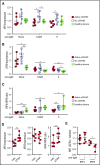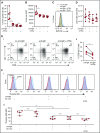An aberrant NOTCH2-BCR signaling axis in B cells from patients with chronic GVHD
- PMID: 28851699
- PMCID: PMC5680609
- DOI: 10.1182/blood-2017-05-782466
An aberrant NOTCH2-BCR signaling axis in B cells from patients with chronic GVHD
Abstract
B-cell receptor (BCR)-activated B cells contribute to pathogenesis in chronic graft-versus-host disease (cGVHD), a condition manifested by both B-cell autoreactivity and immune deficiency. We hypothesized that constitutive BCR activation precluded functional B-cell maturation in cGVHD. To address this, we examined BCR-NOTCH2 synergy because NOTCH has been shown to increase BCR responsiveness in normal mouse B cells. We conducted ex vivo activation and signaling assays of 30 primary samples from hematopoietic stem cell transplantation patients with and without cGVHD. Consistent with a molecular link between pathways, we found that BCR-NOTCH activation significantly increased the proximal BCR adapter protein BLNK. BCR-NOTCH activation also enabled persistent NOTCH2 surface expression, suggesting a positive feedback loop. Specific NOTCH2 blockade eliminated NOTCH-BCR activation and significantly altered NOTCH downstream targets and B-cell maturation/effector molecules. Examination of the molecular underpinnings of this "NOTCH2-BCR axis" in cGVHD revealed imbalanced expression of the transcription factors IRF4 and IRF8, each critical to B-cell differentiation and fate. All-trans retinoic acid (ATRA) increased IRF4 expression, restored the IRF4-to-IRF8 ratio, abrogated BCR-NOTCH hyperactivation, and reduced NOTCH2 expression in cGVHD B cells without compromising viability. ATRA-treated cGVHD B cells had elevated TLR9 and PAX5, but not BLIMP1 (a gene-expression pattern associated with mature follicular B cells) and also attained increased cytosine guanine dinucleotide responsiveness. Together, we reveal a mechanistic link between NOTCH2 activation and robust BCR responses to otherwise suboptimal amounts of surrogate antigen. Our findings suggest that peripheral B cells in cGVHD patients can be pharmacologically directed from hyperactivation toward maturity.
Figures







Comment in
-
Notching up B-cell pathology in chronic GVHD.Blood. 2017 Nov 9;130(19):2053-2054. doi: 10.1182/blood-2017-09-805366. Blood. 2017. PMID: 29122773 No abstract available.
Similar articles
-
BAFF promotes heightened BCR responsiveness and manifestations of chronic GVHD after allogeneic stem cell transplantation.Blood. 2021 May 6;137(18):2544-2557. doi: 10.1182/blood.2020008040. Blood. 2021. PMID: 33534893 Free PMC article.
-
Increased BCR responsiveness in B cells from patients with chronic GVHD.Blood. 2014 Mar 27;123(13):2108-15. doi: 10.1182/blood-2013-10-533562. Epub 2014 Feb 14. Blood. 2014. PMID: 24532806 Free PMC article.
-
B cells in chronic graft-versus-host disease.Hum Immunol. 2019 Jun;80(6):393-399. doi: 10.1016/j.humimm.2019.03.003. Epub 2019 Mar 5. Hum Immunol. 2019. PMID: 30849450 Free PMC article. Review.
-
B cells from patients with chronic GVHD are activated and primed for survival via BAFF-mediated pathways.Blood. 2012 Sep 20;120(12):2529-36. doi: 10.1182/blood-2012-06-438911. Epub 2012 Aug 14. Blood. 2012. PMID: 22896003 Free PMC article.
-
B cells in chronic graft-versus-host disease.Biol Blood Marrow Transplant. 2015 Jan;21(1):16-23. doi: 10.1016/j.bbmt.2014.10.029. Epub 2014 Nov 12. Biol Blood Marrow Transplant. 2015. PMID: 25452031 Free PMC article. Review.
Cited by
-
Human Effectors of Acute and Chronic GVHD Overexpress CD83 and Predict Mortality.Clin Cancer Res. 2023 Mar 14;29(6):1114-1124. doi: 10.1158/1078-0432.CCR-22-2837. Clin Cancer Res. 2023. PMID: 36622700 Free PMC article.
-
XBP-1s Promotes B Cell Pathogenicity in Chronic GVHD by Restraining the Activity of Regulated IRE-1α-Dependent Decay.Front Immunol. 2021 Oct 1;12:705484. doi: 10.3389/fimmu.2021.705484. eCollection 2021. Front Immunol. 2021. PMID: 34659198 Free PMC article.
-
Single-cell landscape analysis unravels molecular programming of the human B cell compartment in chronic GVHD.JCI Insight. 2023 Jun 8;8(11):e169732. doi: 10.1172/jci.insight.169732. JCI Insight. 2023. PMID: 37129971 Free PMC article.
-
What's atypical about human B cells after allogeneic stem cell transplantation?J Leukoc Biol. 2025 May 7;117(5):qiaf048. doi: 10.1093/jleuko/qiaf048. J Leukoc Biol. 2025. PMID: 40273381 Review.
-
Chronic GvHD NIH Consensus Project Biology Task Force: evolving path to personalized treatment of chronic GvHD.Blood Adv. 2023 Sep 12;7(17):4886-4902. doi: 10.1182/bloodadvances.2022007611. Blood Adv. 2023. PMID: 36322878 Free PMC article.
References
Publication types
MeSH terms
Substances
Grants and funding
LinkOut - more resources
Full Text Sources
Other Literature Sources
Miscellaneous

